人教版七年级英语上册Unit7课件讲课教案
- 格式:ppt
- 大小:3.35 MB
- 文档页数:4
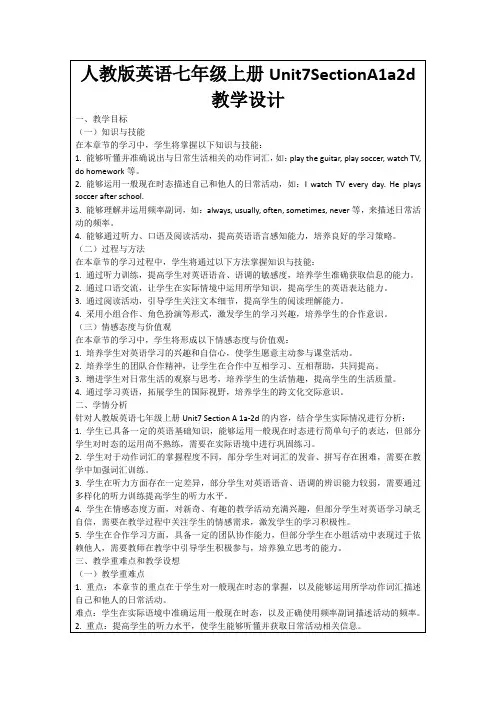
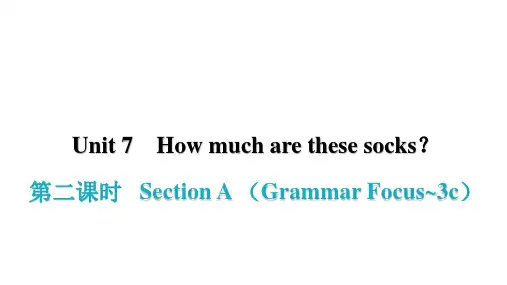
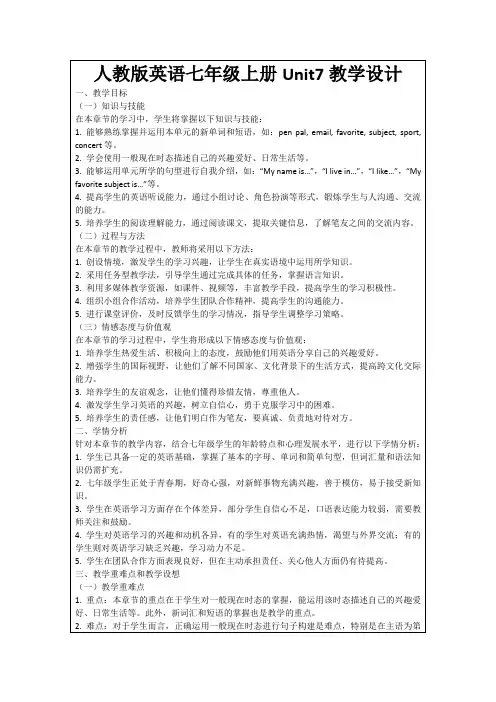
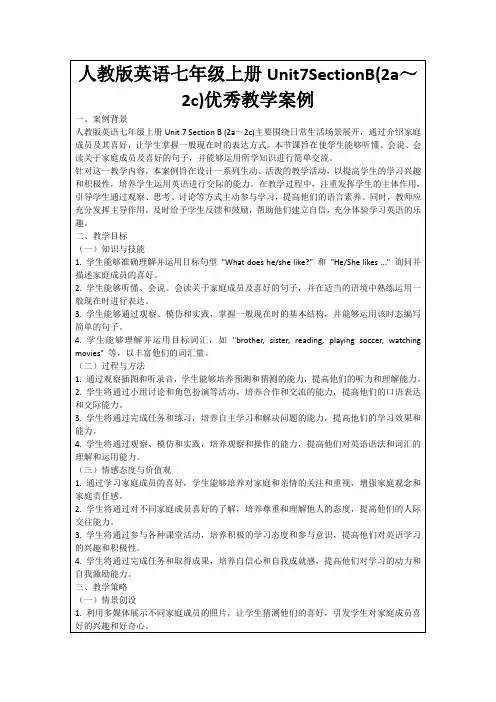
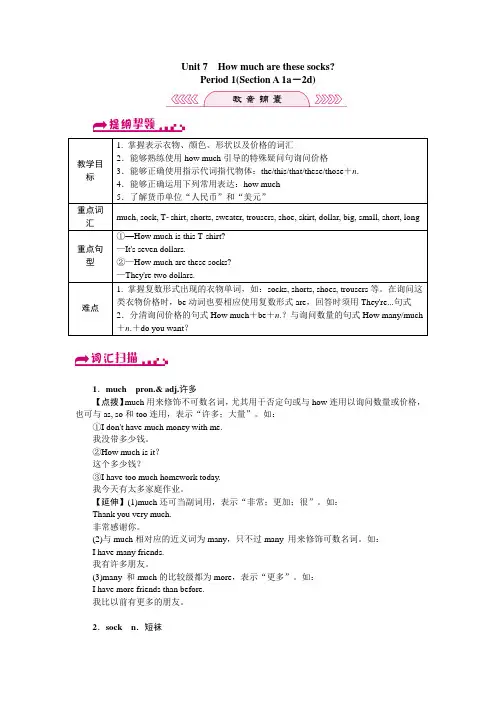
Unit 7How much are these socks?Period 1(Section A 1a-2d)教学目标1. 掌握表示衣物、颜色、形状以及价格的词汇2.能够熟练使用how much引导的特殊疑问句询问价格3.能够正确使用指示代词指代物体:the/this/that/these/those+n. 4.能够正确运用下列常用表达:how much5.了解货币单位“人民币”和“美元”重点词汇much, sock, Tshirt, shorts, sweater, trousers, shoe, skirt, dollar, big, small, short, long重点句型①—How much is this T-shirt? —It's seven dollars.②—How much are these socks? —They're two dollars.难点1. 掌握复数形式出现的衣物单词,如:socks, shorts, shoes, trousers等。
在询问这类衣物价格时,be动词也要相应使用复数形式are,回答时须用They're...句式2.分清询问价格的句式How much+be+n.?与询问数量的句式How many/much +n.+do you want?1.much pron.& adj.许多【点拨】much用来修饰不可数名词,尤其用于否定句或与how连用以询问数量或价格,也可与as, so和too连用,表示“许多;大量”。
如:①I don't have much money with me.我没带多少钱。
②How much is it?这个多少钱?③I have too much homework today.我今天有太多家庭作业。
【延伸】(1)much还可当副词用,表示“非常;更加;很”。
如:Thank you very much.非常感谢你。
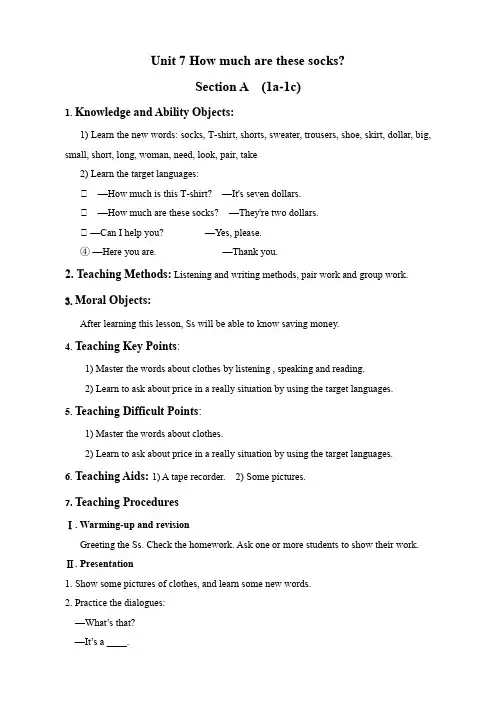
Unit 7 How much are these socks?Section A (1a-1c)1. Knowledge and Ability Objects:1) Learn the new words: socks, T-shirt, shorts, sweater, trousers, shoe, skirt, dollar, big, small, short, long, woman, need, look, pair, take2) Learn the target languages:① —How much is this T-shirt? —It's seven dollars.① —How much are these socks? —They're two dollars.① —Can I help you? —Yes, please.④ —Here you are. —Thank you.2. Teaching Methods: Listening and writing methods, pair work and group work.3.Moral Objects:After learning this lesson, Ss will be able to know saving money.4.Teaching Key Points:1) Master the words about clothes by listening , speaking and reading.2) Learn to ask about price in a really situation by using the target languages.5.Teaching Difficult Points:1) Master the words about clothes.2) Learn to ask about price in a really situation by using the target languages.6. Teaching Aids: 1) A tape recorder. 2) Some pictures.7. Teaching ProceduresⅠ. Warming-up and revisionGreeting the Ss. Check the homework. Ask one or more students to show their work. Ⅱ. Presentation1. Show some pictures of clothes, and learn some new words.2. Practice the dialogues:—What’s that?—It’s a ____.—What color is it?—It’s _____________.How much is/are…?It’s/They’re …3. Ask the students to look at the picture and match the words with the things in the picture. T: Now let's work on 1a. We have some new words on the left of the picture and some things marked with a, b, c... and i. Please match the words with the objects in the picture by writing the letter of the objects on the lines next to the words. The first answer is given.Check the answers by asking some students to read the words and the letters.Ⅲ. Listening1. T: Next we’ll hear a conversation about shopping. The recording will be played twice.For the first time, listen to it carefully.T: For the second time, please circle the things in the picture you hear.2. Check the answers. (Ask the students to listen to the recording and compare theiranswers with those in the recording.)3. Now close your books listen again and fill in the blanks.How much is the _____?It’s ____ dollars.And how much are these ______?Oh, _______ eight dollars.And this _______? How much is it?Let’s see. It’s _____ dollars.Ⅳ. Pair work1. Ask students to work in pairs and practice the conversations in la.2. Make their own conversations with their partners.3. Ask some pairs to act out their conversations.Ⅴ.Homework:Make a conversation according to 2e.Section A (2a-2e)1. Knowledge and Ability Objects:1) Learn the new words: socks, T-shirt, shorts, sweater, trousers, shoe, skirt, dollar, big, small, short, long, woman, need, look, pair, take2) Learn the target languages:① —How much is this T-shirt? —It's seven dollars.① —How much are these socks? —They're two dollars.① —Can I help you? —Yes, please.④ —Here you are. —Thank you.2. Teaching Methods: Listening and writing methods, pair work and group work.3.Moral Objects:After learning this lesson, Ss will be able to know saving money.4.Teaching Key Points:1) Master the words about clothes by listening , speaking and reading.2) Learn to ask about price in a really situation by using the target languages.5.Teaching Difficult Points:1) Master the words about clothes.2) Learn to ask about price in a really situation by using the target languages.6. Teaching Aids: 1) A tape recorder. 2) Some pictures.7. Teaching ProceduresⅠ. Warming-up and revisionGreeting the Ss. Check the homework. Ask one or more students to show their work. Ⅱ. Presentation1. Show some pictures of clothes, and learn some new words.2. Practice the dialogues:—What’s that?—It’s a ____.—What color is it?—It’s _____________.How much is/are…?It’s/They’re …3. Ask Ss to show the dialogue.Ⅲ. Listening1. Show students some pictures of colors.T: These are different colors. What colors are they?S: They are black, white, red, green, blue and yellow.2. Show a big hat and a small hat.T: Look! This hat is big. It's a big hat. And this hat is small. It's a small hat.(Write "big" and "small" on the Bb.)3. Show a long T-shirt and short T-shirt.T: Look! This T-shirt is long. It's a long T-shirt. And this T-shirt is short. It's a short T-shirt.(Write "long" and "short" on the Bb.)4. Now look at words in 2a. Listen to the recording and repeat after the recording.(Play the tape for the Ss listen and repeat.)Ⅵ. Listening1. Ask the students to do listening to the conversations in 2b and circle the things they hear. T: Today is Sunday. Alan is shopping with her sister. They are going to buy some clothes and some other things. Now I will play the recording about the conversation.Play the recording for the first time. Listen carefully and circle the things you hear. Play the recording again to check the answers.2. Ask the students to do listening to the conversations in 2c and fill in the price tags.Play the recording and ask the students to fill in the price tags. Then check the answers.Ⅳ. Pair work1. Then let's ask and answer questions about the things in 2c in pairs. e.g.S1: I like these shorts. How much are they?S2: They're six dollars.2. Ss practice the conversation with their partners. Then make other conversations about the things in 2c.3. Let some Ss act out their conversations.Ⅴ.Homework:Make a conversation according to 2e.Section A (Grammar Focus-3c)1. Knowledge and Ability Objects:1) Review the words about colors and clothes by speaking, reading and writing.2.Review how to ask and answer the price.①—How much is…? —It's…②—How much are…? They're …3) Learn the usage of Demonstrative Pronoun and Adjective about colors.2. Teaching Methods: Pair work, task-based teaching method.3. Moral Objects: Learn how to go shopping in English and talk about the colors and price.4. Teaching Key Points:1) Sum up how to ask and answer the price about different types and colors.2) Be able to ask the price about different types and colors according to different situations.5. Teaching Difficult Points: Be able to ask the price about different types and colors according to different situations.6. Teaching Aids: 1) A tape recorder. 2) CAI. 3) A blackboard.7. Teaching ProceduresⅠ. RevisionI. Say out the words according to the pictures.II. Say out the words and phrases.1. sock (复数) ______2. shoe (复数) ______3. dollar (复数) _______4. big (反义词) ______5. long (反义词) ______6. white (反义词) _____7. 多少钱__________________8. 绿色的毛衣_______________9. 红色的短裤____________10. 怎么样?_______________________11. 您需要什么吗?________________12. 三美元两双______________________13. 我将要买它(们)_______________III. Work in pairs. Ask and answer.How much is/are…?It’s… /They’re…Ⅱ. Grammar Focus1. Complete the sentences according to the Chinese.①那顶帽子多少钱?五美元。

人教版七年级英语上册unit 7 教学设计一、教材分析(一)教材的地位及作用1、新目标英语教材概述《新目标英语》教材的语言教育理念是:知识用于行动强调“语言应用”,培养“创新、实践能力”,发展“学习策略”。
它采用任务型语言教学(Task-based Language Teaching)模式。
教材中每单元都设计一个或几个与该单元话题有关的任务,让学生在完成任务的过程中,使用英语获取信息,用英语进行交流,培养运用英语解决实际问题的能力。
2、单元分析及教材处理本课是新目标英语七年级下册第2单元,教材以I’m more outgoing than my sister. 为中心话题,围绕着描述“人物的特性”展开,学习和运用形容词的比较级,让学生能表述个人的特征,能用比较级对人进行对比描述。
本课教学内容与学生的实际生活密切相关,易于引发学生运用简单的英语进行交际和交流。
在学习活动中,学生通过对周围人物的描述及看法,促进学生之间和师生之间的情感交流,增进情谊。
(二)教学目标根据《英语课程标准》关于总目标的具体描述,结合第七单元的教材内容,我按语言知识、语言技能、学习策略、情感态度、文化意识五个方面将本单元的教学目标细化:语言知识目标1.掌握本课的词汇(主要是:描述人物的词汇)描述外貌:tall short heavy thin long hair short hair描述性格:quiet outgoing calm wild serious funny其它(身体/头脑/年龄/勤奋等):athletic weak smart foolishyoung old hard-working lazy2、掌握语法1)形容词的比较级的构成2)学会用比较级来进行比较语言技能目标能表述个人的特征,能用比较级对人进行对比描述。
(三)教学重点及难点重点难点1.复习词汇tall short heavy thin long hair short hair quiet outgoing calm wild serious funny athletic weak smart foolish young old hard-working lazy等2.句型: Which is bigger, the apple or the orange? Yao Ming is taller than Liu Xiang. Yao Ming ismuch taller than Pan Changjiang.3.形容词比较级的构成及形容词比较级的用法二、学情分析1.初中学生的抽象思维能力较低,形象思维能力强,但注意力容易分散。
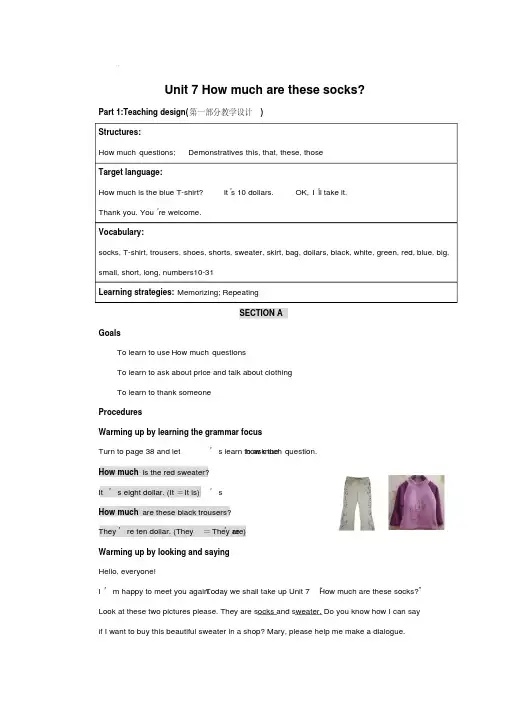
精品资料Unit 7 How much are these socks?Part 1:Teaching design(第一部分教学设计)Structures:How much questions; Demonstratives this, that, these, thoseTarget language:How much is the blue T-shirt?It’s 10 dollars. OK, I’ll take it.Thank you. You’re welcome.Vocabulary:socks, T-shirt, trousers, shoes, shorts, sweater, skirt, bag, dollars, black, white, green, red, blue, big, small, short, long, numbers10-31Learning strategies: Memorizing; RepeatingSECTION AGoalsTo learn to use How much questionsTo learn to ask about price and talk about clothingTo learn to thank someoneProceduresWarming up by learning the grammar focusTurn to page 38 and let’s learn to ask thehow much question.How much is the red sweater?=It is)It’s eight dollar. (It’sHow much are these black trousers?=They are)They’re ten dollar. (They’reWarming up by looking and sayingHello, everyone!I’m happy to meet you again. Today we shall take up Unit 7 “How much are these socks?”Look at these two pictures please. They are socks and sweater. Do you know how I can sayif I want to buy this beautiful sweater in a shop? Mary, please help me make a dialogue.Suppose you are the salesperson and I’m the customer. I’ll ask you, How much is this sweater? You tell me the price, for example, it’s 10dollars. And I’ll say, OK, I’ll take it.have a try.Now let’sT: How much is this sweater?Mary: It’s 10 dollars.T: I’ll take it.The rest of you shall listen carefully and repeat after us.1a Matching wordsLook at the picture on page 37 in your book. What can you see in the picture? That’s right. There are many clothes and some people in the shop. Can you name these clothes? Now match the words with the objects in the picture by writing the letters of the objects on thelines next to the words. Then check the answers.1b Listening and circlingLook at the picture again and tell me the names of the items of clothing to make sure you know these words. Now let’s listen to the recording and circle the clothing item you hear.1c Doing pairworkNow practice the conversation in the box. And then make your own conversations.Sample conversations:1. A: How much is this sweater? B: It’s thirty dollars.2. A: How much are these shorts? B: They are eight dollars.I’ll ask some pairs to say your conversations to the class.2a Listening and repeat.On page 38 are eight colored boxes. Point to them and read their names out. They are black, white, red, green, blue, yellow, brown and purple. And here are two caps and two T-shirts. Which one is big and which one is small? Which one is short and which one is long? Point to them and read the words aloud.Small big short long2b Listening and circlingNow look at the six pictures in 2b. We shall listen to six conversations about them. Listen carefully and circle the picture of the article of clothing the person is talking about.Then check the answers with all the class.2c Listening and fillingListen to the recording again. This time please write down the prices on the price tags. Allthe items in each group are the same price.2d doing pairworkJust now we heard something about the items of clothing in the pictures in 2b. We now know their colors, prices and so on. Now look at the dialogue in the illustration in 2d and make your own conversations in pairs like that using the items of clothing in the pictures in2b. Then I’l l ask some pairs to perform your conversations for us.Sample dialogue:S1: How much are the blue shorts?S2: They are nine dollars.S1: How much is the yellow T-shirt?S2: It’s eight dollars.2d Role-playLook at the picture in 2d. What item is the girl buying? Yes, she’s buying a blue sweater. Here is an conversation about the picture.Reading the conversation first. Then practice it with your partners, supposed that one of you is Marry, and the other one is the woman. I’ll ask some pairs to perform it for us.Underline the focus sentences for shopping.Culture note: The difference between Thanks, Thank you, and Thank you very much Thanks is used in informal situations or in situations when the person helped you in a notvery important way. Thank you is the standard form, which is acceptable in all situations. Thank you very much is used only when someone has done something special to help you. The tone of voice can also add meaning to a statement of thanks. A warm, meaningful Thanks sometimes means a lot more to the listener than a more formal Thank you.Presentation the grammar patterns in the unit. Read and practice in pairs.3a Making sentencesMake sentences in the chart with the words in the three boxes in 3a. Then ask some students to present the sentences they have made.3b WritingLet’s look at the pictures in 3b. There are some clothing with their price tags. Fill the blanksin the left to complete the questions and answers. Then read the conversation in 3a in pairs. 3c Doing pairworkAsk and answer questions with your partners. You can make a conversation by asking oneof you to guess the price tags of the clothing in 3b.SECTION BGoals●To learn the numbers 10-31●To improve the listening and writing skillsProceduresWarming up by talking about plansLast class we learned how to buy a thing and how to talk about the price. When we talk about the price, we’ll use the numbers. And you have learned the numbers1 to 9. This class we’ll study the numbers 10 to 31.1a listening and repeatingLook at the numbers in the box in 1a on page 44. Listen to the recording and repeat one by one. Please pay more attention to the pronunciation of twenty and thirty.They are often pronounced differently than they are spelled. The word twenty is often pronounced twenny. The second “t” disappears. This is especially true when the twenty is followed by another number as in twenty-one. Also, the second “t” in the word thirty often sounds like a “d”. Most native speakers of English sounded like they’re saying thirdy instead of thirty.1b Writing the numbersJust now we listened to the numbers from ten to thirty-one.Now please match the numerals and number words individually and findout which rows are in the wrong order.Check the answer: The second row and the fourth row are in the wrong place.1c Listening and circlingNow we are going to hear a conversation between a mother andher daughter. They are talking about buying clothes. Listencarefully and circle the numbers you hear the mother and thedaughter say. One of the numbers is given.1d Listening and circlingLet’s listen to the conversation again. This time please circle the things that Lisa and her mother talk about.1e Doing a pairworkNow let’s do pairwork . Read the dialogue in the speech bubble and make your conversations about the clothes in the picture in 1d. Then I’ll ask some pairs to say your conversation to class.Sample conversation:S1: How much is the white T-shirt?S2: It’s 11 dollars. How much are the shoes?S1: They are 8 dollars….2a MatchingMatch each clothing item listed in the box in 2a with a price listed in the right.2b Reading and fillingHere is an advertisement in the newspaper about SALE. You see, the red or green sweater is only 15 dollars. Read the advertisement carefully and fill in the rest of the price tags. While reading try to divide / the sentences into pOK, now please read aloud the advertisement. When you read, you should pay more attention to the pronunciation and intonation.2c Filling the blanksSopposed that you are working at Mr. Cool’s Clothes Store.Complete the conversations and practice it in a group of three.3a Filling the adLook at the picture in 3a and fill the blanks to make a ad for Huaxing Clothes Store.3b Writing an advertisementNow you can write your own advertisement. Use this ad to write your ad. Suppose you are next door to Huaxing. Your ad must be better! Then I’ll ask some pairs to read your ads to the class.Sample ad:Mr Zhang’s Clothes SaleCome to Mr Cool’s Clothes Store! We sell trousers for only ¥30. Do you like hats? We have several kinds of lovely hats for ¥5 each! We also have great bags for only ¥8! For students, we have some kinds of shoes at a very good price—only¥20! They are very cool! And that’s not all!Come and see for yourself at Mr Cool’s Clothes Store!Closing down by reviewing the main points*How much are the shorts?*They are 10dollars.*How much is the blue sweater?*It’s 25 dollars.*I’ll take it.*We have sweaters at a very good price—only 25dollars.*You can buy socks for only 2dollars each.SELF CHECKGoals●To revise the words presented in this unit●To practice readingProcedures1 DescripingDescribe the clothes that your teacher and partner wear today .Then fill the box in the right.2 Ordering the sentencesLet’s read the sentences first. Then put the sentences below in order to make a conversation about shopping.Part 2: Teaching Resources(第二部分:教学资源)I.Background readings1. Kinds of shopsShops are divided into multiple categories of stores which sell a selected set of goods or services.Many shops are part of a chain: a number of similar shops with the same name selling the same products in different locations. The shops may be owned by one company, or there may be a franchising company that has franchising agreements with the shop owners (see also restaurant chain).Some shops sell second-hand goods. Often the public can also sell goods to such shops. In other cases, especially in the case of a nonprofit shop, the public donates goods to the shop to be sold (see also thrift store). In give-away shops goods can be taken for free.For details on the various types of retail stores see:Army-navy stores; Bookstore; Convenience store; Department store; Dollar store; Electronic commerce, B2C; General store; Hardware store; Hobby store; Hypermarket; Mail order; Pet store; Pharmacy; Sex shop; Sports Store; Supermarket; Superstore; Surplus store; Thrift store; Travel agency2. 英国购物习惯在英国有一些购物习惯与我们国家的做法不同。
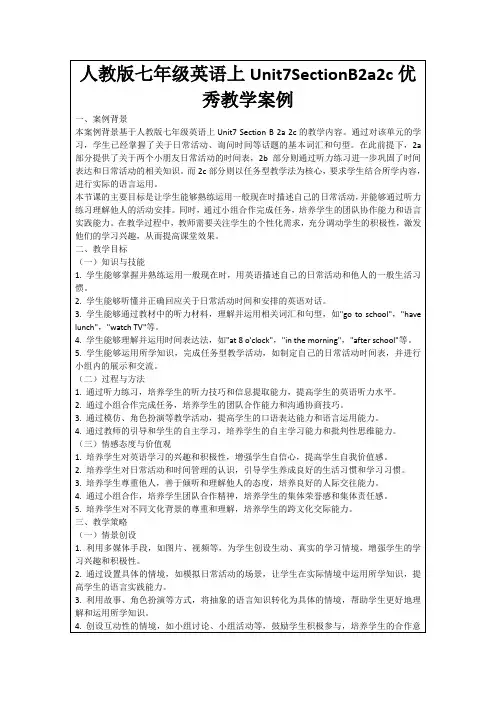

七年级上册英语⼈教版第七单元教案 科学的英语七年级上册教案设计总是以某种教学理论为依据的。
下⾯⼩编给⼤家分享⼀些⼈教版七年级上册英语第七单元的教案,⼤家快来跟⼩编⼀起欣赏吧。
七年级上册英语⼈教版第七单元教案设计 Unit7 How much are these socks? 话题购物 功能询问价格;谈论⾐物;提供帮助;感谢他⼈ 重难点 how much引导的特殊疑问句 10以上基数词表达⽅法 重点单词socks, T-shirt, pants, shoes, shorts, sweater, bag, dollar, black, small, short, long, numbers,eleven,twelve,thirteen,fifteen,twenty,thirty,forty 句型:How much is the red sweater? It’s eight dollars. What’s the price of the red sweater? It’s eight dollars. How much are these black pants? They’re ten dollars. What’s the price of these black pants? They’re ten dollars. Can I help you?=What can I do for you? Yes, please. I want a sweater. 知识点讲解 1,“成双成对”的单词 英语中表⽰成双成对的单词或者由两部分组成的物品,常常以复数出现。
socks shorts pants/trousers shoes glasses (1)这类名词作主语时,谓语动词⼀般⽤复数形式 How much are these shorts? (2)若要表⽰⼀双,⼀副时,⽤a pair of,谓语动词⽤单数。
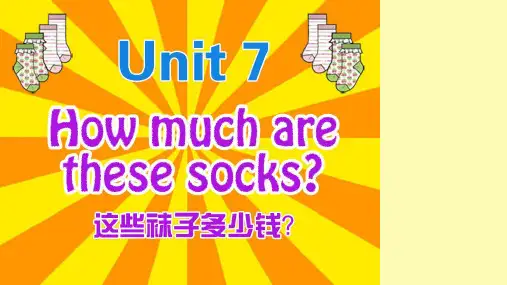
Unit 7 How much are these socks?话题Topic 购物Shopping功能Functions 1.能够就衣物的价格进行问答Ask about pricesA:How much is the white bag?B:It’s seventeen dollars.A:How much are these socks?B:They’re two dollars.2.能够谈论衣物的颜色和大小Talk about clothing A:What color do you want?B:Blue.I like big purple hats.I like those long blue and yellow socks.3.能够为他人提供帮助或对别人的帮助礼貌地做出应答Offer helpA:Can I help you?B:Yes, please.4.能够表达感谢或对别人的感谢礼貌地做出应答Thank someoneA:Thank you.方法语言交际活动,培养口语交际的能力和在日常生活中运用英语的能力。
2.通过图片提供的语境,感知、学习Howmuch is this T-shirt? It’s sevendollars.How much are…? They are…句型,从而引出本单元的话题。
创设情境学习、操练购物对话,借助多媒体和游戏来提高学生学习的主动性和积极性。
情感态度与价值观1.了解西方购物礼仪。
2.培养学生合理购物的好习惯。
3.培养学生在购物过程中讲礼貌的良好品质。
SectionA 概述1.Section A主要围绕“购物”这个话题展开,集中呈现了10个表示衣物名词、8个表示颜色的形容词和4个描写大小、长短的形容词。
复习基数词1-9,以及指示代词this,that,these,those。
核心句型是How much 引导的特殊疑问句询问价格,以及其他购物常用语。